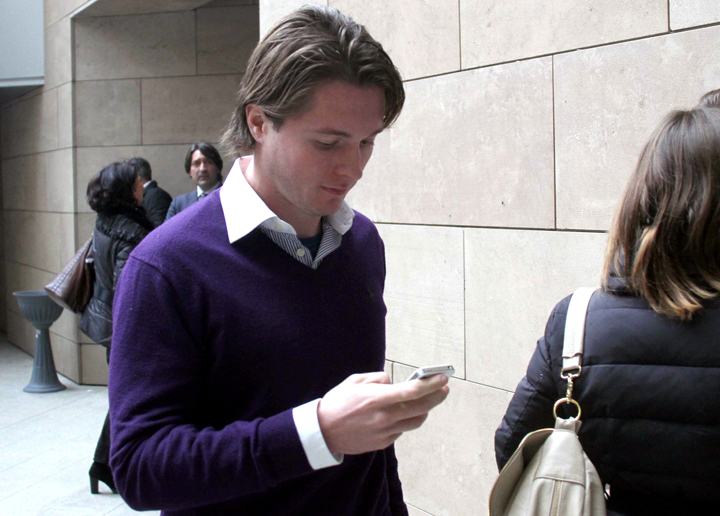FLORENCE, Italy – The defence lawyer for the former boyfriend of U.S. exchange student Amanda Knox told an appeals court Thursday that the young lovers were blamed by authorities for the murder of British student Meredith Kercher to calm any fears that a monster was loose in their Italian university town.

Defender Giulia Bongiorno said her client, Raffaele Sollecito, and Knox were identified as suspects in a “record” four days after the murder in the picturesque central town of Perugia because authorities “did not want to think that a stranger, a monster, could have entered a house and murdered a student.”
READ MORE: Prosecutor demands guilty verdict for Amanda Knox
Bongiorno said much of the evidence later used to convict the pair in their first trial – including the presumed murder weapon found in Sollecito’s kitchen drawer and a clasp that had been ripped from Kercher’s bra – had not even been gathered by investigators at that point.
Bongiorno, on the last day of closing arguments in the pair’s third trial, showed a court a series of slides and videos in a bid to dismantle the prosecution’s case.
Sollecito sat placidly at her side throughout.
Kercher, 21, was found murdered in her bedroom in the apartment she shared with Knox and two others on Nov. 2, 2007, having been sexually assaulted and stabbed.
In their first trial, Knox and Sollecito were sentenced to 26 years and 25 years, respectively, in proceedings that made headlines around the world.
Italy’s high court ordered the case back to trial after vacating their 2011 acquittals, blasting the appeals court’s handling of the case. While Sollecito, now 29, has attended several hearings, Knox, 26, remains in Seattle, where she returned a free woman after her acquittal.
A third man, Ivory Coast-born Rudy Hermann Guede, is serving a 16-year term in the case after being convicted in a separate trial.
Prosecutors initially said Kercher was killed in a drug-fueled sex game that went bad. But in this trial, Prosecutor Alessandro Crini has backed away from the orgy scenario presented by colleagues in the previous trials. Now he is arguing that the violence was triggered when Guede failed to flush a toilet, igniting an alleged dispute between the roommates over cleanliness.
Bongiorno, the defence lawyer, argued that the young lovers had no motive for the crime, noting their romance was just 9 1/2 days old when Kercher’s half-naked body was discovered.
“The relationship between Amanda and Raffaele was tender, just bloomed, and it had nothing to do with a 50s-something’s searching for thrills,” Bongiorno said.
The two, she said, liked to cuddle and rub noses like Eskimo kisses, which she called “unca nunca.”
“Unca nunca has nothing to do with bunga bunga,” Bongiorno said, eliciting a rare moment of laughter of the long day of arguments with the reference to former Premier Silvio Berlusconi’s infamous parties with scantily clad would-be showgirls.
Bongiorno said Sollecito never met Guede before the crime “and it is absurd to think that they met that night.” She also argued against the theory that there were multiple assailants, and said the knife found at Sollecito’s house was too large to have been the murder weapon.
The defence lawyer blasted alleged evidence used to link Sollecito to the murder, showing a slide of a bloody footprint on a bathroom rug attributed to him but which she said was the wrong size and model.
“There was an enormous error in the print attributed to Sollecito,” she said.
Turning to a clasp ripped from Kercher’s bra – the only piece of evidence linked to Sollecito that was found in Kercher’s bedroom – she said it had been contaminated. Bongiorno showed a photo of the clasp on Nov. 3, 2007, under a pillow at the scene of the crime – noting that it wasn’t catalogued as the bra had been.
In another photo taken 46 days later, the clasp is found beneath a rug and at that point taken as evidence. In the interim, Bongiorno said more than 30 people had entered the crime scene in the meantime.
“The clasp was 1.5 metres (4 1/2 feet) from where it was 46 days later. It means someone or something moved it,” she said.
Bongiorno showed another slide, indicating that the clasp appears to have been stepped on between the first and second inspections.
And she showed a video of the search of the room when the clasp was found, pointing out that the investigator’s gloves were dirty and that the clasp was placed back on the ground of the well-trampled room for a photograph before being put in an evidence bag.
The court has set Jan. 20 for rebuttals by both sides. It is set to begin deliberations on Jan. 30, and a verdict is likely that day.



Comments